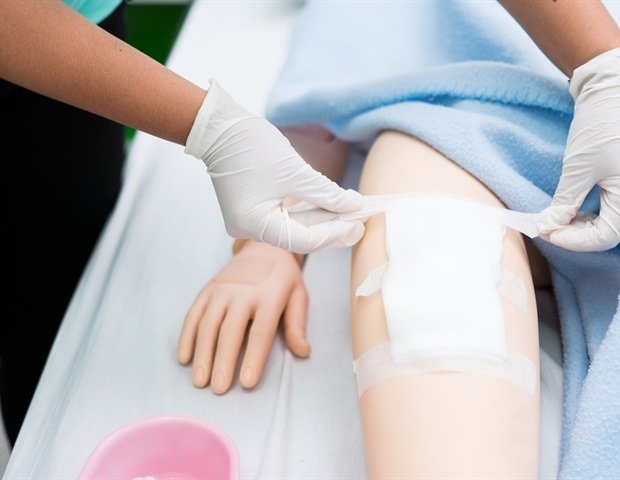Changi General Hospital (CGH) and the Singapore University of Technology and Design (SUTD) have developed the Blood WArning Technology with Continuous Haemoglobin (BWATCH) sensor, a lightweight monitoring device placed over a patient’s bandage that detects real-time bleeding from wound sites following invasive medical procedures.
BWATCH was tested and validated in an observational clinical trial involving 250 patients at CGH with a dialysis catheter inserted or removed. The device was securely placed over their dressing for at least six hours. During the trial, 36 episodes of bleeding occurred and the sensor detected all instances of early bleeding. The blood loss detected in the bleeding episodes was minimal and the bandages were only partially stained.
The nursing staff were alerted to the bleeding when the alarm was triggered and took the necessary actions to prevent an escalation of the bleeding. The findings from the clinical trial have been published in Scientific Reports, A device for surveillance of vascular access sites for bleeding: results from a clinical evaluation trial by Chionh, C.Y., Soh, D.Y., Tan, C.H. et al.
CGH and SUTD have patented BWATCH in Singapore and the United States (US), with future plans of commercialisation with suitable industry partners. BWATCH is the first joint patent between CGH and SUTD under a partnership to develop innovative patient care solutions to address evolving healthcare challenges.
Enhancing patient safety with continuous real-time monitoring
In developed countries like Singapore, the incidence of acute dialysis is estimated to be at 200-300 per million population each year. Patients with acute dialysis have acute illnesses, which can lead to a sudden deterioration of their kidney functions, such that the kidney is not able to sustain life. When this occurs, the patient will require haemodialysis, a life-saving therapy to filter out waste products from the blood.
BWATCH is developed with haemodialysis patients in mind to meet a clinical need, as there is a risk of bleeding occurring after a catheter is inserted during vascular access procedures. The wound sites for these patients are usually heavily bandaged and covered under blankets as they rest. To ensure that patients are recovering well, the care team conducts regular inspections, as many as four times in an hour, to check for any potential bleeding.
Designed to complement patient care and enhance patient safety, BWATCH’s ability to detect bleeding early will reduce the risk of a potential major bleeding episode. The device is also useful in the care of patients who are incapacitated and unable to call for assistance. As more confidence is gained from wider use of this device, the frequency of inspections and resource requirements may be reduced with no compromise to safety.
“Heavy bleeding following medical procedures is rare but when it occurs, it can be life-threatening. Monitoring at short intervals is highly manpower intensive but necessary. However, despite close monitoring, bleeding may still occur between these inspections. BWATCH offers continuous monitoring, allowing the care team to focus on other patient-centric tasks,” said Associate Professor Chionh Chang Yin, Chief and Senior Consultant, Department of Renal Medicine at CGH.
Using light absorption properties to detect blood
Unlike other blood-detection devices, BWATCH’s main underlying detection principle is based on the light absorption properties of haemoglobin. The innovation also includes a moisture-detecting sensor that does not require direct contact with the liquid. With these two properties, the device is able to differentiate blood from other types of fluids such as sweat and urine, accurately detecting the bleeding episode and triggering the alarm without requiring direct contact with the patient or patient’s bodily fluids. (refer to Annex for more details) “While there are other commercial systems and products that are available for fluid detection, they are only able to detect the presence of fluids by changes in physical properties such as electrical resistance, capacitance or opacity to light. None of the detection methods were specific for blood, making BWATCH a precise non-invasive sterile monitoring device for early detection of bleeding,” said Associate Professor Foong Shaohui, Department of Engineering Product Development at SUTD.
Potential future applications
Besides haemodialysis patients, BWATCH is applicable to other patient types within the hospital. It can be used on other wound types or locations that are prone to external bleeding, for example in post-cardiac catheterisation. Cardiac catheterisation is a procedure used to diagnose and treat certain cardiovascular conditions. During the procedure, a catheter is inserted into an artery and threaded through the blood vessels, which leads to the heart. The wound site is a potential area of bleeding. The device can also be tested in other clinical situations beyond the hospital setting, such as on-site monitoring of traumatic wounds. The shape of the device would have to be adapted for different wound types.
In addition, there is potential for the device to be integrated into hospital systems, such as linking it directly to the nurses’ call system. “Bringing BWATCH to market will offer many possibilities in the early detection of bleeding,” said A/Prof Chionh.
